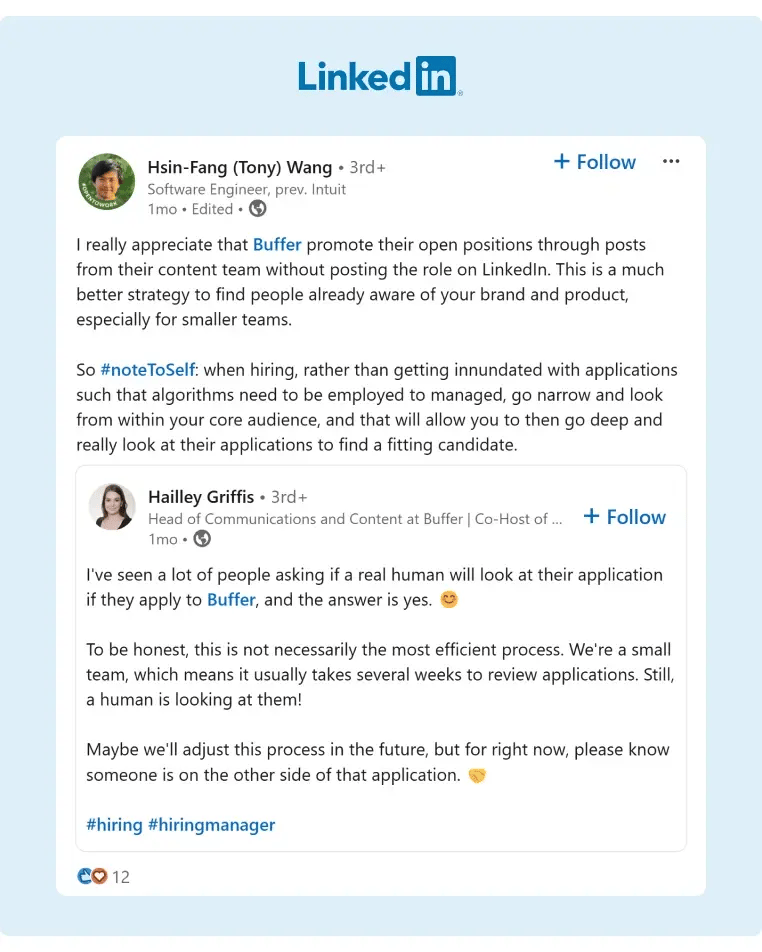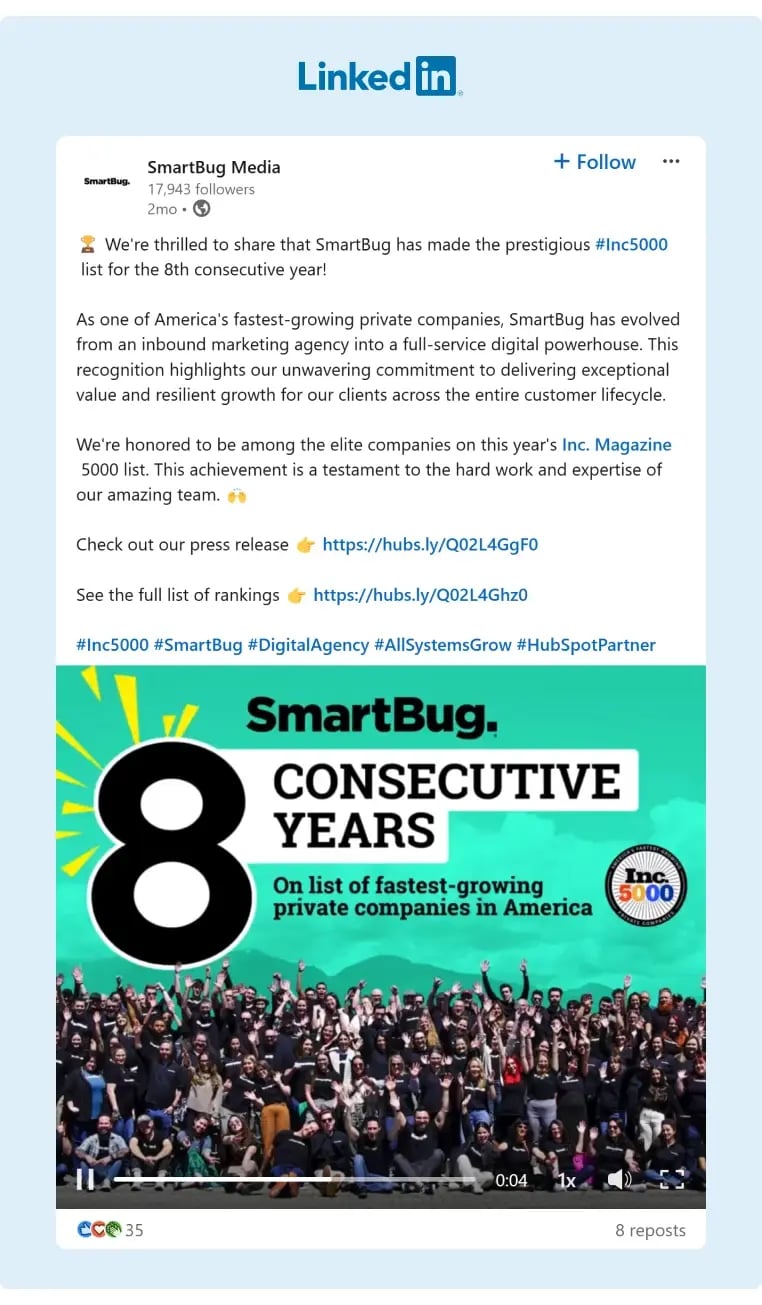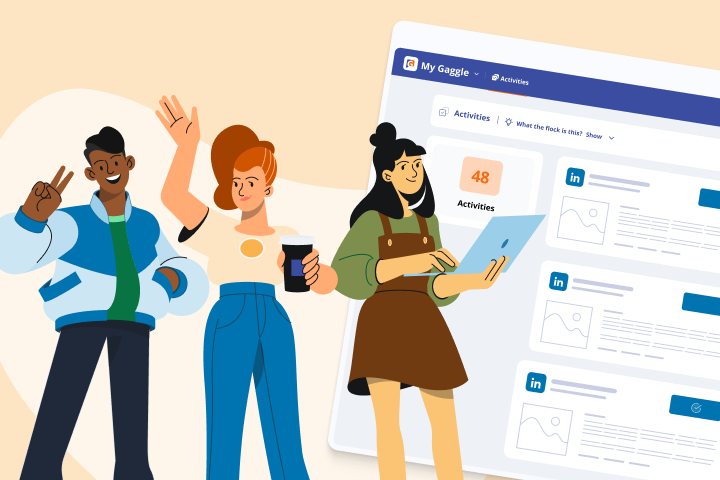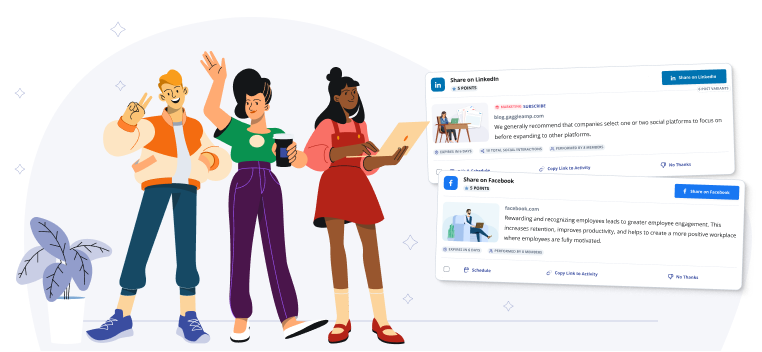Key Strategies To Attract, Engage, and Retain Employees
Long gone is the classic “banker’s hours” work day model. Today’s companies, especially tech, offer a variety of work models including in-office, remote, hybrid, and on-the-go. As a result, these employers can’t rely on offering competitive salaries and benefits along with using old school marketing strategies to attract, engage, and retain top talent.
These companies need to establish an attractive brand identity that showcases why current and potential employees want to work for them.
In this article, first, we’ll explain the importance of crafting a strong employer brand along with implementing an employee advocacy program. Then, we’ll show you how social posts on LinkedIn can help you attract and engage new employees. In particular, we’ll dive into how strong thought leadership posts can help keep you attuned to the pulse of what your company does and how it resonates with its audience.
Ready to enhance your workplace’s initial appeal and attract and retain the best talent? Let’s get started.
The Importance of a Strong Employer Brand
Having a strong employer brand is crucial for companies looking to recruit and retain employees. It encompasses the company’s mission, values, and culture, which impacts (positively or negatively) its identity, reputation, and perception by current and future employees.
Giving your employer branding a boost on social media, is a surefire way to give your company a competitive edge. Here’s why: 79% of job seekers use social media for their job search and 84% of organizations use social platforms as a recruiting tool.
To attract top talent, carefully articulate your company’s mission and values in social posts. It’s wise to assume that applicants will seek out online employee testimonials —- both present and past —- on your social platforms and also on third-party sites like Glassdoor and LinkedIn. In fact, one in three surveyed job seekers won’t apply for a company after reading negative employer reviews, so bear this in mind.
Implementing an employee advocacy program can help encourage your employees to share insights into their workplace on social media, which builds your company’s reputation as a strong and desirable employer.
Why You Need an Employee Advocacy Program
Transforming your employees into brand ambassadors is considered a best practice in employer branding for good reason. Social posts created (and shared) by employees are viewed as authentic and credible by potential candidates.
An effective employee advocacy program can help you tap into your employees’ social networks to boost your brand’s reach and credibility. However, getting employees to create and share content consistently across social platforms isn’t easy, which is why you need an employee advocacy tool like GaggleAMP.
Our easy employee advocacy platform streamlines the content creation and sharing process plus:
- Increases Employee Engagement by Providing Specific, Personalized Instructions.
- Provides Detailed Analytics and Proprietary Employee Advocacy Benchmarking Data.
- Offers a Robust AI Tool To Make Content Creation Easier.

With an employee advocacy program (and platform) in place, the next step is to use strategically crafted social posts. Let’s take a look at how to use these posts to attract and engage employees.
How To Use Social Posts to Attract and Engage Employees
Creating and sharing social media posts is a great tactic to spur engagement and maximize recruitment. Social media marketing on LinkedIn, in particular, is ideal because you can find your target audience by job title, interests, and locations and create custom content for them.
Here are six types of posts you can use to attract and engage current and potential employees on LinkedIn:
1. Work-Life Balance and Flexibility
Employees value work-life balance and flexibility more than ever before. So, consider crafting social posts that highlight your company’s:
- Flexible-working hours.
- Compressed working weeks.
- Remote or hybrid-working models.
- Generous paid time off and parental leave policies.
These posts are ripe for being reshared by your audience with its network, especially when hiring. In particular, hiring posts that are transparent about the recruitment process go a long way with applicants. Here, an individual who uses Buffer shares a hiring post with his network:

Source: Hsin-Fan (Tony) Wang
Potential candidates who see these social posts and value these aspects of work life and recruitment will be more inclined to join your organization and stay for the long haul.
2. Professional Growth and Development
Individuals looking to both grow with a company and grow their career will gravitate towards social posts that focus on professional growth and development opportunities. Share posts that describe how current (and potential) employees can upskill their talent and further their learning and development opportunities with your company.
For example, by mentioning industry-certified courses, cross-departmental training, or blended learning progression paths, your company will be recognized as an empowering and supportive workplace. Investing in your employees’ growth will demonstrate your commitment to their long-term success and fulfillment, which can be a crucial tool for attracting and retaining more talent in the future.
In this example, Accenture does a great job of highlighting its professional growth opportunities for employees:

Source: Accenture
3. Employees’ Well-being
Many employees leave their jobs due to feeling burned out, overworked, and stressed out. According to a Monster poll on Mental Health in the Workplace, three out of four workers say their mental health at work is negative. The study goes on to highlight that 67% of workers feel they work in a toxic environment, 78% of workers don’t think their employer is doing enough to address mental illness at work, and 61% would rather quit while 39% would rather get laid off from their job than work in a toxic workplace.
These statistics are particularly relevant to the tech industry who experienced a number of large layoffs in 2024. By the end of the summer, 384 tech companies had laid off more than 124,000 employees, which included Intel who reduced its workforce by 15,000 employees.
So, it comes as no surprise that tech employees have been experiencing rising anxiety due to job stability. As a result, they are coffee badging, updating resumes, upskilling, making new connections, and casually applying to jobs so they aren’t caught off guard in case of layoffs.
To attract these individuals who are looking for a more stable, non-toxic work environment, focus on social posts that highlight how your company values the well-being of its employees.
For example, share posts that show how you support anxious employees in the workplace. Perhaps, you offer mental health training to managers, time off for mental health treatment, or flexible schedules for employees to work from home as needed.
Here, Slack shares a post encouraging its audience to prioritize themselves during Mental Health Awareness Month.

Source: Slack
4. Staff Achievements
71% of employees would be less likely to leave their organization if they were recognized for their contributions more frequently. Employees want to feel valued and appreciated for their efforts, which is why developing a comprehensive reward and recognition system goes a long way toward retaining and recruiting employees.
When you celebrate high-performing employees or milestone moments, share posts highlighting them on LinkedIn. Not only will you spur engagement with current employees, but you’ll attract potential candidates who will be intrigued by how you build up, support, and recognize your staff’s contributions.
In this example, SmartBug shares it has made Inc. 5000’s list for the eighth consecutive year, giving credit and thanks to its team for their hard work and expertise.

Source: SmartBug Media
5. Workplace Culture
When it comes to attracting candidates to your organization, first impressions matter. Having a positive workplace culture is a major deciding factor when it comes to recruiting new talent. Your workplace culture encompasses the beliefs, values, attitudes and behaviors which make up the work environment (e.g, work hard, play hard). If you work in-person in a unique office setup (e.g., Google), in your social posts, consider leveraging high-quality pics and videos to emphasize your office architecture.
Sharing behind-the-scenes pics of your work environment helps potential candidates envision themselves in your workplace, which helps cultivate a positive first impression before they even set foot in the door.
In this example, ClickUp shares a behind the scenes peek into filming its corporate jargon videos with a fun bloopers reel. Not only does ClickUp create fantastic social media content, but they also have a good time doing it.

Source: ClickUp
6. Thought Leadership
Another great LinkedIn content idea is thought leadership posts, which not only grow your connections but also build credibility. Potential job seekers want to work for companies and individuals who are credible and have authority within their industry.
Thought leadership posts can include thoughts and opinions on relevant industry news and trends as well as sharing articles and case studies as HubSpot does here:

Source: HubSpot
Final Thoughts
These key strategies and examples are just a few ways to better attract, engage, and retain candidates. When used together, they combine to create an approach that goes beyond traditional recruitment, giving organizations the best possible chance to set themselves apart from the competition online.
Remember the goal is not simply to fill positions as quickly as possible. It’s about building a collaborative and impactful workplace that comprises a team of motivated, engaged, and aligned employees who are committed to their success as well as that of the company.
To give your recruitment and retention efforts a boost, consider using an employee advocacy tool like GaggleAMP. Employee advocacy enables your employees to authentically promote and engage with your brand, which boosts your visibility as an attractive employer.
Schedule a demo today and experience firsthand why more than 100,000 people trust GaggleAMP for employee advocacy.








